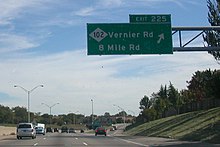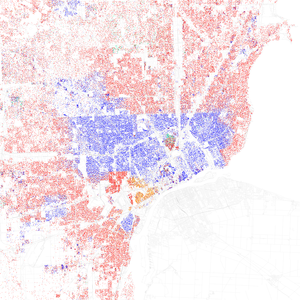M-102 (Michigan highway)
| 8 Mile Road | ||||
M-102 highlighted in red | ||||
| Route information | ||||
| Maintained by MDOT | ||||
| Length | 20.804 mi[1] (33.481 km) | |||
| Existed | c. 1928[2][3]–present | |||
| Major junctions | ||||
| West end | ||||
| ||||
| East end | ||||
| Location | ||||
| Country | United States | |||
| State | Michigan | |||
| Counties | Wayne, Oakland, Macomb | |||
| Highway system | ||||
| ||||
M-102 is an east–west state trunkline highway in the US state of Michigan that runs along the northern boundary of Detroit following 8 Mile Road. The highway follows the Michigan Baseline, a part of the land survey of the state, and the roadway is also called Base Line Road in places. As a county road or city street, 8 Mile Road extends both east and west of the M-102 designation, which leaves 8 Mile on the eastern end to follow Vernier Road. The western terminus of M-102 is at the junction of 8 Mile Road and M-5 (Grand River Avenue) and the opposite end is at Vernier Road and Interstate 94 (I-94). The 8 Mile Road name extends west to Pontiac Trail near South Lyon with a discontinuous segment located west of US Highway 23 (US 23). The eastern end of 8 Mile Road is in Grosse Pointe Woods, near I-94, with a short, discontinuous segment east of Mack Avenue.
The highway was first designated in the late 1920s, connecting US 10 (Woodward Avenue, now M-1) with US 25 (Gratiot Avenue, now M-3). Extensions to the highway designation moved the termini in the 1930s and 1940s east to M-29 (Jefferson Avenue) and US 16 (Grand River Avenue, now M-5). A change in the 1960s added a section of north–south roadway to the eastern end of M-102; that change was reversed within about a year. A western extension along Grand River Avenue in 1977 was reversed in 1994, and M-102 has remained the same since.
As the long northern border of the city of Detroit, 8 Mile Road has carried major cultural significance; since the mid-20th century parts of the road has served as a physical and cultural
Route description
Starting at an intersection with Hamburg Road along the
M-102 starts at the intersection between M-5 (Grand River Avenue) and 8 Mile Road and runs eastward along 8 Mile Road. The highway widens out into a

Continuing east, M-102 intersects M-39 (Southfield Freeway) and M-10 (Lodge Freeway) south of the Southfield campus of Oakland Community College and the Northland Center Mall. As the highway approaches M-1 (Woodward Avenue), there are a pair of service drives that split from the main roadway in each direction to provide access through the interchange with M-1. The main lanes of M-102 pass under M-1 and its ramp connections before the service drives merge back in on the other side. This interchange is located adjacent to the Michigan State Fairgrounds, former site of the now-defunct Michigan State Fair, and Woodlawn Cemetery.[6][7] East of the fairgrounds, the highway crosses a line of the Canadian National Railway that also carries Amtrak passenger traffic;[9] the line is south of a rail terminal in Ferndale. Further east, M-102 meets I-75 before intersecting Dequindre Road. Dequindre is the boundary between Oakland and Macomb counties.[6][7]
Now following the Wayne–Macomb county line, M-102 separates Warren from Detroit. The highway also runs parallel to, and about a half mile (0.8 km) north of Outer Drive,[6][7] the original beltway highway proposed in 1918 to encircle Detroit.[10] The road passes the Mound Road Engine facility, a former Chrysler plant next to the Mound Road intersection. East of the plant,[6][7] the highway crosses a branch line of the Conrail Shared Assets Operations on the east side of the plant complex[9] before intersecting M-53 (Van Dyke Road).[6][7] Further east, 8 Mile Road passes north of the Bel Air Center Shopping Center before crossing another Canadian National Railway line[9] next to the intersection with M-97 (Groesbeck Highway).[6][7]

On the far east side of Detroit, M-102 separates the city from the suburb of
History
M-102 was first designated along 8 Mile Road from US 10 (Woodward Avenue, now M-1) to US 25 (Gratiot Avenue, now M-3) in late 1928 or early 1929.[2][3] In 1939, the eastern terminus was moved as M-102 was extended along 8 Mile and Vernier Roads to end in Grosse Pointe Shores at M-29 (Jefferson Avenue).[11][12] The highway was extended in the early 1940s from Woodward westward to US 16 (Grand River Avenue, now M-5).[13][14]
During 1963, the M-102 designation was extended northerly along Jefferson Avenue through St. Clair Shores, replacing the M-29 designation to the Shook Road interchange at the northern end of the then-existing I-94 freeway.[15][16] That extension was reversed the next year, and M-102 was scaled back to end at US 25 (Gratiot Avenue); the rest of 8 Mile and Vernier roads plus the Jefferson Avenue segment are added to M-29 instead.[16][17] M-102 was re-extended along 8 Mile and Vernier roads to the I-94 interchange in Harper Woods in 1970 replacing M-29; the remainder of that other highway along Vernier Road and Jefferson Avenue to Shook Road that was once part of M-102 was transferred to local control.[18][19]
When
Cultural impact
Racial and economic divide

White Black Asian Hispanic Other (Each dot represents 25 people)
The road has long served as a
According to the
The movie
In surveying

8 Mile Road is also known as Base Line Road, for it was used to set the baseline for the Public Land Survey System in Michigan. The system helped bring order to county boundaries, which had often been set in other states by geographic markers such as rivers, hills, and trees, and were therefore rather irregular. Today, the baseline forms the northern or southern boundary of many southern Michigan counties.[28]
Major intersections
| County | Location | mi[1] | km | Destinations | Notes |
|---|---|---|---|---|---|
| Oakland–Wayne county line | Farmington Hills–Livonia city line | 0.000 | 0.000 | 8 Mile Road west | 8 Mile Road extends westward to Pontiac Trail |
Detroit | Cloverleaf interchange | ||||
| 5.198 | 8.365 | Detroit | Exit 15 on M-39 | ||
| 6.015 | 9.680 | Detroit | Exit 13 on M-10; no control cities eastbound; grade separation at Greenfield Road with access via M-10 ramps | ||
Detroit | Three-level diamond interchange | ||||
Detroit | Exit 59 on I-75 | ||||
Detroit | |||||
| 16.290 | 26.216 | Detroit | |||
Detroit | |||||
| Eastpointe–Harper Woods city line | 19.731 | 31.754 | 8 Mile Road east | M-102 follows Vernier Road; 8 Mile continues east to Mack Avenue | |
Detroit Vernier Road east | Exit 225 on I-94; Vernier Road continues east to Lake Shore Drive | ||||
| 1.000 mi = 1.609 km; 1.000 km = 0.621 mi | |||||
See also
References
- ^ a b Michigan Department of Transportation (2021). Next Generation PR Finder (Map). Michigan Department of Transportation. Retrieved October 11, 2021.
- ^ .
- ^ .
- .
- ISBN 978-0-937247-34-1– via Internet Archive.
- ^ .
- ^ a b c d e f g h Google (June 11, 2012). "Overview Map of M-102 (8 Mile Road)" (Map). Google Maps. Google. Retrieved June 11, 2012.
- ^ Alpert, Steve. "M-102, 8 Mile Road". Alp's Roads. Retrieved June 11, 2012.
- ^ a b c Michigan Department of Transportation (January 2011). Michigan's Railroad System (PDF) (Map). Scale not given. Lansing: Michigan Department of Transportation. Retrieved February 1, 2011.
- ISSN 0746-4045. Retrieved June 12, 2012.
- OCLC 12701143.
- OCLC 12701143. Retrieved October 17, 2019 – via Michigan History Center.
- OCLC 12701143. Archived from the originalon April 22, 2017. Retrieved January 2, 2017 – via Archives of Michigan.
- OCLC 12701143.
- OCLC 12701120. Retrieved October 17, 2019 – via Michigan History Center.
- ^ . Retrieved October 17, 2019 – via Michigan History Center.
- OCLC 12701120. Retrieved October 17, 2019 – via Michigan History Center.
- OCLC 12701120.
- .
- OCLC 12701177.
- OCLC 12701177.
- ^ Greenwood, Tom (January 28, 1999). "M-5 'Haggerty Connector' Work To Be Done by 2001". The Detroit News.
- Honolulu Advertiser. Associated Press. September 28, 2008. Retrieved June 11, 2012.
- ^ a b Chinni, Dante (November 15, 2002). "Along Detroit's Eight Mile Road, a stark racial split". The Christian Science Monitor. Retrieved June 11, 2012.
- ^ "U.S. Census website". United States Census Bureau. Retrieved January 31, 2008.
- ^ Logan, John R.; Stults, Brian (2011). "The Persistence of Segregation in the Metropolis: New Findings from the 2010 Census" (PDF). Census Brief prepared for Project US2010. Project US2010. p. 6. Retrieved June 11, 2012.
- ^ Abbey-Lambertz, Kate (December 6, 2017). "Eminem's Childhood Home in Detroit Burns After Woman Tried to Purchase It". HuffPost. Retrieved May 16, 2021.
- ISSN 0022-1341.
External links
- M-102 at Michigan Highways


